A Guide to Fabric Weaves for Workwear: Choosing the Best for Your Logo
XAMAX® know that choosing the right fabric weave for your workwear or work uniform isn't just about comfort—it's about durability, appearance, and how well your logo stands out.
Whether you're selecting shirts, polo shirts, or hoodies for your team, understanding the different weaves can help you make the best choice for your needs.
In this article, we’ll explain common weaves found in our product range and their benefits, particularly in a workwear context, including considerations for embroidery and printing.
- Page Contents
- What Is a Weave?
- How Weave Impacts Logo Application
- Fabric Weaves for Workwear
- Why XAMAX® Is Your Best Choice for Work Uniforms
- Conclusion
What Is a Weave?
A weave refers to how threads are interlaced to create a piece of fabric. This construction affects the fabric’s texture, strength, and overall performance.
- Warp Threads: The vertical threads that run lengthwise on the loom, providing the fabric's foundation.
- Weft Threads: The horizontal threads woven over and under the warp, forming the fabric's pattern.
The interaction between the warp and weft threads determines the unique properties of each weave, impacting everything from breathability to how well a fabric holds up to logo embroidery or printing.
How Weave Impacts Logo Application
Embroidery
The type of weave influences how well a logo can be embroidered. Fabrics with a tighter weave, like poplin, provide a stable surface for crisp and well-defined embroidery. In contrast, textured weaves, like pique, may require adjustments to maintain clarity.
Printing
Some weaves work better for printed logos than others. Smooth, tightly woven fabrics ensure that printed designs appear sharp and vibrant, while textured or looser weaves can make the print look uneven or less clear. We’ll highlight these factors as we discuss each weave.
Fabric Weaves for Workwear
Plain Weave (AKA Poplin)
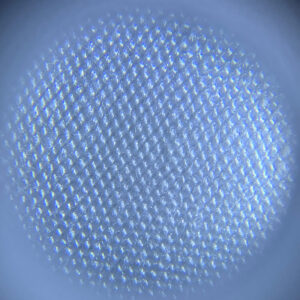
Characteristics: The plain weave is the simplest and most versatile of all weaves. Each warp thread crosses each weft thread in a one-over, one-under pattern, creating a smooth and uniform surface.
How It Works: The even construction results in a lightweight and durable fabric, commonly found in workwear shirts and uniform trousers.
Common Uses: Dress shirts, blouses, and lightweight trousers that require a polished appearance.
Benefits for Workwear:
- Durability: The tight structure ensures the fabric holds up well to repeated washing and daily wear, making it ideal for uniforms.
- Versatility: Suitable for both formal and casual settings, offering a clean, professional look.
- Embroidery: The smooth surface of plain weave fabric provides an excellent base for embroidery, ensuring logos appear crisp and detailed without distortion.
- Printing: Perfect for printed designs, as the even weave prevents ink from spreading, resulting in sharp and vibrant logos.
Oxford Weave
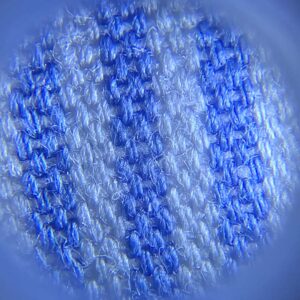
Characteristics: The Oxford weave is a basket weave that combines multiple weft and warp threads, giving the fabric a soft yet textured feel. It’s breathable and durable, with a slightly casual look.
How It Works: The fabric is created by weaving two warp threads over a single weft thread, giving it a subtle texture that adds character to shirts.
Common Uses: Casual work shirts and polo shirts, offering a balance between comfort and durability.
Benefits for Workwear:
- Comfort: Soft to the touch and breathable, making it comfortable for long shifts or active roles.
- Durability: The basket weave structure is robust, standing up to heavy use while maintaining a tidy appearance.
- Embroidery: The textured surface requires thoughtful embroidery placement to ensure logo clarity, but it holds up well to wear.
- Printing: While suitable for smaller printed logos, the textured weave may slightly impact the sharpness of intricate designs, so simpler logos are best.
Piqué Weave
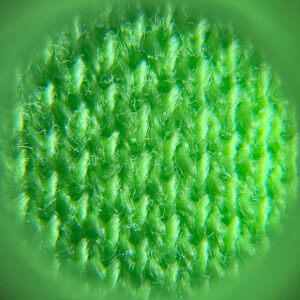
Characteristics: Piqué is a textured weave known for its raised parallel cords or fine ribbing, commonly used in polo shirts. The unique construction allows for better airflow, keeping the wearer cool.
How It Works: The weave creates a bumpy texture by using a double-knit process, adding both visual interest and functionality.
Common Uses: Polo shirts and sports uniforms, where breathability and comfort are essential.
Benefits for Workwear:
- Breathability: The open weave promotes airflow, making piqué ideal for hot or physically demanding environments.
- Professional Appearance: The structured fabric holds its shape well, giving a polished look that’s appropriate for various settings.
- Embroidery: Fine embroidery details can get lost in the texture, so thicker threads or simplified logos are recommended for the best results.
- Printing: The uneven surface is not ideal for large printed logos, as the texture can disrupt the clarity of the design. Small, bold prints work better.
Ripstop Weave

Characteristics: Ripstop fabric is woven with a reinforced grid pattern, making it highly resistant to tearing. It’s lightweight yet incredibly durable, designed for demanding environments.
How It Works: Thick reinforcement threads are interwoven at regular intervals, creating a grid that prevents rips from spreading.
Common Uses: Outdoor workwear, jackets, and trousers for physically demanding roles.
Benefits for Workwear:
- Extreme Durability: Withstands heavy use and harsh conditions, ideal for outdoor and industrial jobs.
- Lightweight: Provides strength without the bulk, ensuring comfort and flexibility.
- Embroidery: Large, bold logos are recommended, as the grid pattern may interfere with fine details.
- Printing: The grid structure can impact the appearance of printed designs, making it better suited for bold and simple prints.
Twill Weave
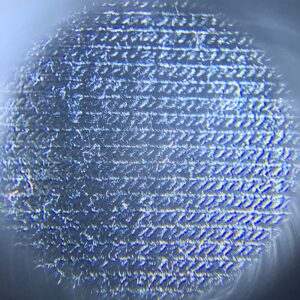
Characteristics: Twill weave is easily recognised by its diagonal rib pattern, which adds strength and texture to the fabric. It’s a dense and smooth weave that drapes well and is often used for heavier workwear.
How It Works: The diagonal lines are formed by weaving the weft thread over one or more warp threads and then under two or more warp threads. This creates a sturdy and flexible fabric.
Common Uses: Work trousers, denim, and heavy-duty shirts where extra strength is needed.
Benefits for Workwear:
- Strength: Twill weave is highly abrasion-resistant, making it suitable for physical work environments where durability is key.
- Wrinkle Resistance: Naturally resists wrinkles and stains, keeping uniforms looking fresh with minimal maintenance.
- Embroidery: Ideal for bold, larger logos. The ribbed texture may require slight adjustments for intricate embroidery designs to ensure they remain legible.
- Printing: Works well for bold printed logos, but the texture may cause minor variations in ink distribution, making it less suitable for intricate or small designs.
Herringbone Weave
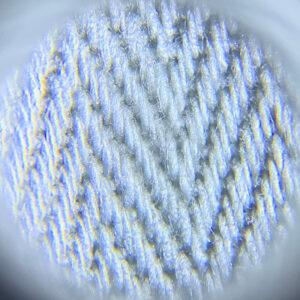
Characteristics: The herringbone weave is named for its distinctive V-shaped, zigzag pattern that resembles a fish’s skeleton. It’s a variation of the twill weave that adds texture and a touch of elegance.
How It Works: The diagonal lines alternate direction, creating a zigzag effect that enhances the fabric’s strength and appearance.
Common Uses: High-end work shirts, blouses, and sometimes trousers where a more refined look is required.
Benefits for Workwear:
- Stylish and Functional: Combines the strength of twill with a sophisticated look, making it perfect for office settings or client-facing roles.
- Durability: Retains its structure and performs well in demanding environments, holding up to regular wear and washing.
- Embroidery: The textured pattern works best with simpler logos, as intricate designs may be less legible.
- Printing: The zigzag pattern may affect the appearance of printed designs, so it’s better suited for small, uncomplicated logos.
Houndstooth Weave
Characteristics: Houndstooth is a classic pattern achieved through a variation of the twill weave, creating a broken check design that’s both stylish and functional.
How It Works: The pattern is formed by alternating groups of dark and light threads, creating a distinctive tooth-like check.
Common Uses: Fashionable work blouses and shirts for roles that require a standout appearance.
Benefits for Workwear:
- Distinctive Style: Perfect for uniforms where a touch of personality is needed, without sacrificing professionalism.
- Durability: Withstands daily wear and tear, ideal for both office and physical roles.
- Embroidery: Simpler, bold logos work best, as the intricate pattern can make details difficult to see.
- Printing: The busy pattern can clash with printed logos, so it’s recommended for use with solid-coloured logos or embroidery.
Jacquard Weave
Characteristics: Jacquard weave allows for intricate and elaborate patterns to be woven directly into the fabric, making it both luxurious and durable. It’s created using a Jacquard loom, which controls each warp thread individually.
How It Works: The intricate designs are woven, not printed or embroidered, giving the fabric a textured and elegant look.
Common Uses: Premium work shirts, blouses, and upscale uniforms where a refined appearance is essential.
Benefits for Workwear:
- Luxurious Appearance: Adds a touch of sophistication, perfect for executive uniforms or client-facing roles.
- Durability: Despite the complex patterns, Jacquard fabrics are strong and long-lasting, holding up well to wear.
- Embroidery: Works best with logos that complement the design of the fabric; simpler designs may be more legible.
- Printing: Not ideal for printed logos, as the textured surface can interfere with the clarity of the design.
Denim Weave

Characteristics: Denim is a variation of the twill weave, characterized by its diagonal ribbing and rugged construction. Traditionally made with a blue warp and white weft, denim is a durable and versatile fabric commonly found in workwear trousers.
How It Works: The twill weave structure ensures durability and abrasion resistance, while its heavy weight makes it ideal for physically demanding jobs.
Common Uses: Work trousers, jackets, and heavy-duty uniforms for outdoor or industrial roles.
Benefits for Workwear:
- Exceptional Durability: The twill weave makes denim one of the strongest fabrics, perfect for jobs requiring heavy-duty clothing.
- Stain and Dirt Resistance: The thick, textured fabric helps hide dirt and stains, making it ideal for rugged environments.
- Embroidery: Denim provides a stable surface for embroidery, making bold and large logos stand out beautifully. However, intricate designs may need simplification to prevent distortion due to the fabric's texture.
- Printing: Suitable for bold, simple printed designs. The texture of denim can cause minor variations in ink application, but this adds character to the print.
4-Way Stretch Weave
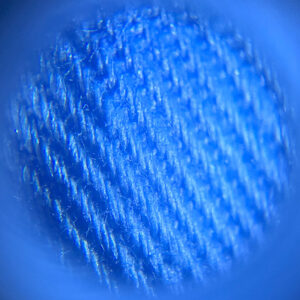
Characteristics: 4-way stretch fabric is designed for maximum flexibility, allowing the material to stretch both lengthwise and widthwise. This innovative fabric construction is often used in activewear and modern work uniforms requiring freedom of movement.
How It Works: The weave combines elastic fibers, such as spandex or elastane, with traditional warp and weft threads, resulting in a fabric that can stretch and recover without losing its shape.
Common Uses: Work trousers, polo shirts, and jackets for roles requiring a full range of motion, such as construction, logistics, and healthcare.
Benefits for Workwear:
- Flexibility and Comfort: Provides superior freedom of movement, making it ideal for physically demanding roles or active workplaces.
- Durability: Designed to withstand repeated stretching and movement, ensuring the garment retains its shape over time.
- Embroidery: Logos on 4-way stretch fabrics require careful planning to avoid puckering or distortion. Special stabilisers can be used to ensure embroidery remains crisp and professional.
- Printing: Perfect for printed logos, as the smooth surface allows for sharp, vibrant designs. However, stretchable printing methods, such as heat transfers or vinyl, are recommended to maintain the logo's integrity when the fabric stretches.
Why XAMAX® Is Your Best Choice for Work Uniforms
At XAMAX®, we pride ourselves on being the leading supplier of high-quality workwear and uniforms in the UK. Here’s what sets us apart:
Award-Winning Embroidery and Printing
Our expertise in embroidery and printing is nationally recognised, earning us awards for the exceptional quality of our craftsmanship. We use state-of-the-art equipment and industry-best practices to ensure your logo looks sharp, professional, and long-lasting, whether embroidered or printed.
Customisation You Can Trust
From fine, detailed embroidery to vibrant, full-colour printing, our team ensures your logo is perfectly executed on your chosen workwear. We understand the nuances of different fabric weaves and tailor our techniques to suit each material, guaranteeing a flawless result every time.
Tiered Volume Pricing
We know that outfitting an entire team can be a significant investment. That’s why XAMAX® offers tiered volume pricing, giving you cost-effective solutions as your order size increases. The more you order, the more you save, making us the ideal partner for businesses of any size.
Exceptional Customer Service
Our team is dedicated to helping you find the perfect uniform solution. From product selection to logo application, we work with you every step of the way to ensure your team looks and feels their best.
With XAMAX®, you’re not just getting high-quality workwear; you’re investing in a trusted partner who understands your business needs and delivers outstanding results every time.
Conclusion
Choosing the right fabric weave is crucial for ensuring your workwear looks professional, performs well, and showcases your logo perfectly. With XAMAX®'s award-winning embroidery and printing services, you can be confident that your team’s uniforms will represent your brand at its best.
Ready to outfit your team in high-quality workwear?






